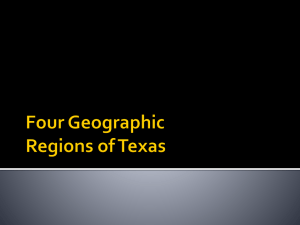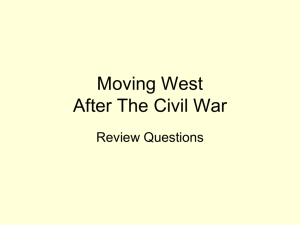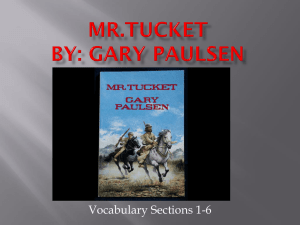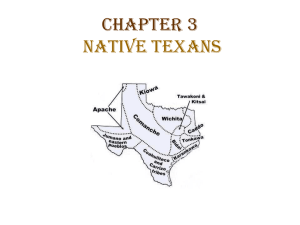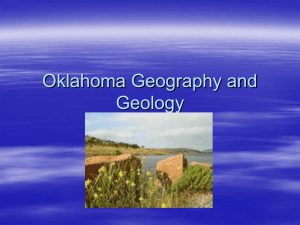Power Point: Texas Tour
advertisement
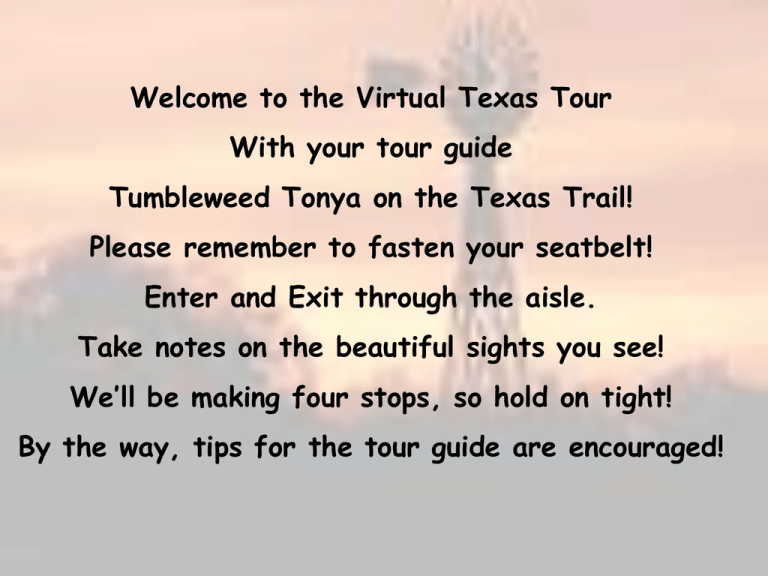
Welcome to the Virtual Texas Tour With your tour guide Tumbleweed Tonya on the Texas Trail! Please remember to fasten your seatbelt! Enter and Exit through the aisle. Take notes on the beautiful sights you see! We’ll be making four stops, so hold on tight! By the way, tips for the tour guide are encouraged! Our first stop is the Mountains and Basins region! The Mountains and Basins region is the most western region of Texas. It is the highest and driest part of Texas. Mountains and Basins Region Mountains and Basins Region A basin is a low, bowl-shaped land with higher ground all around it. The basins in this Texas region are deserts. This region has all of Texas’ mountains and valleys. The mountains in Texas are part of the Rocky Mountains which stretch through the western United States from Mexico to Canada. The Texas Rocky Mountains are made up of many small mountain ranges. Mountains and Basins Region of Texas The Davis Mountains are about in the center of the Mountains and Basins region. The Chisos Mountains are in the south. The Guadalupe Mountains are to the north. Guadalupe Peak is the highest point in Texas at 8,749 feet above sea level. The Chihuahuan Desert is located in this region. Prickly pear cactus grows here. Big Bend National Park is located in a gigantic bend in the Rio Grande River. 99% of the park is desert! Did you know the largest pterodactyl bone ever discovered was found right here in Big Bend National Park? It had a wingspan of 51 feet and was found by Douglas A. Lawson in 1971. This is the city of El Paso. The name is Spanish for “The Pass”. El Paso is the largest city in this region of Texas. Okay, everyone back on the bus! Make sure you took plenty of notes! • This region is located in West Texas. • This region has all of Texas’ mountains and valleys. • This land is mostly desert. It has the least amount of rainfall in Texas. • El Paso is the biggest city. • Big Bend National Park is located here. Our second stop is the Coastal Plains region! The Coast Plains are mostly flat land that lies alongside an ocean. Coast Plains cover near one third of the state of Texas! Coastal Plains Region This the Piney Woods of east Texas. It was once the home of the Caddo Indians. Our state bird, the mocking bird, lives here. They got their name from their unique ability to copy or “mock” other birds. The pecan tree is also found here. It is the state tree of Texas. Pecan tree Mocking bird Weather in the Coastal Plains region is usually mild. That means that winters are short and warm compared to other parts of the country. Summers are long, hot, and humid. There are lots of rivers and lakes in this region. Perfect for fishing and water sports. Fishing in Texas The Coastal Plains of Texas lie alongside an ocean. All rivers that flow west drain into the Gulf of Mexico. Many people visit the beaches that lie along Texas. Shipping is a huge industry in this region. Corpus Christi and Houston have huge ports where ships from all over the world visit to load and unload goods. A cargo ship Corpus Christi Houston Farming and ranching are important industries in the Coastal Plains region. In Kingsville, you will find King Ranch. It was started in the late 1800s by Captain Richard King and his wife Henrietta. It is still one of the largest cattle ranches in Texas today. In the southern most area of Texas known as “The Valley”, some crops are grown all year due to the warm weather. Crops include cotton, sugar cane, citric fruits, soybeans, and corn. Oil is found in the Coastal Plains region. These tall structures are oil derricks. Many people call the oil found in Texas “Black Texas Tea”. Many large cities are located in the Coast Plains including Dallas, Austin, and Houston. Although Austin is our state’s capital, Houston is the state’s largest city. Houston is also the fourth largest city in the U.S.! Houston Austin Dallas Okay, everyone back on the bus! Make sure you took plenty of notes! • This region is located in southern and eastern Texas • This region is very flat so it’s very easy to build large cities like Houston, Dallas, Austin, Corpus Christi, San Antonio, and Laredo. • This region gets the most rainfall in Texas. It’s also very hot and has mild winters. • Farming, ranching, shipping, and oil are largest industries in this region. Our third stop is the High Plains region! The High Plains region is also known as part of the Great Plains. Most of the Texas panhandle is located here. High Plains Region Land in the High Plains region is higher, but more level than in other regions. It’s very high in elevation, but is still very flat. In the southern part of the High Plains is a landform called the Edwards Plateau. It’s very high and flat, like a table. The southern and eastern parts have hills though. This area of Texas is often called the “Hill Country”. In the Texas panhandle is a landform called the Cap Rock Escarpment. This is where the rolling Central Plains meet the high, flat land of the High Plains. In the southern part of the High Plains is another escarpment called the Balcones Escarpment. Spanish explorers called it that because it looked like “balconies” Palo Duro Canyon is the largest canyon in the U.S. It is sometimes called the “Grand Canyon of Texas”. Palo Duro Canyon is located just south of Amarillo. The High Plains region is very dry and has little water supply. Early settlers faced many droughts and sandstorms. However in the winter, the panhandle will often get blizzards, a very harsh snow storm. Blizzard in the Panhandle Sandstorm in the Panhandle Ranching is very popular in the High Plains. Flat grassy land is perfect for raising cattle. What you don’t see are armadillos. It’s much too cold here! Not up in the panhandle! Longhorn cattle Wheat and cotton are important crops in the High plains. Wheat can grow in areas with little water. Two major cities in the High Plains are Lubbock and Amarillo. Both cities grew after railroads were built in Texas. Railroads carried the cattle to markets back east. Today, both Lubbock and Amarillo are home to many different industries, including farming, cattle ranching, gas, oil, health care, and tourism. Okay, everyone back on the bus! Make sure you took plenty of notes! • • • • • • • Very high, flat land Plateaus, mesas, and canyons Region is very dry with little rain Cooler land because of high elevation Major cities: Amarillo and Lubbock Important crops: cotton and wheat Caprock Escarpment separates the Great Plains from the Central Plains Our last stop is the Central Plains region!The Central Plains region is in the center of Texas. It has a little higher elevation than the Coast Plains region rising from 600 ft. to about 2,000 ft. above sea level. Central Plains Region The Central Plains has a little higher elevation than the Coast Plains. The land rises from 600 feet above sea level to about 2,000 feet about sea level. The Central Plains Region is a rural area, not having a high population. It has warmer summers and cooler winters. There are many cattle ranches here. Rolling hills cover much of the Central Plains in Texas. In many places in the Central Plains, rivers and streams have cut steep-sided hills and valleys into the land. This area is often called the Rolling-Hills Region. Fort Worth was one of many stops along the famous cattle drive trail known as the Chisholm Trail. The Chisholm Trail was started by a Cherokee trader. Cowboys and cowgirls in this region still work on cattle ranches. Many compete in rodeos around the country. Did you know that after the Civil War, about one third of the Texas cowboys were African-American or Mexican-American? And several were women! Fort Worth is one of the larger cities in the Central Plains region. It is known for its stockyards and cowboys. One little critter you might see in the Central Plains is the horned toad. You don’t see them often, but if you do, be careful! They are on the threatened animals list. This means the species is threatened of being extinct. Okay, everyone back on the bus! Make sure you took plenty of notes! • This region is know for its rolling hills. • The Central Plains are slightly higher than the Coastal Plains. • Many cattle ranches are located here. • It is rural, not highly populated. • Fort Worth, Abilene, and several military bases are located in the Central Plains.

